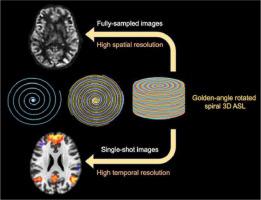当前位置:
X-MOL 学术
›
NeuroImage
›
论文详情
Our official English website, www.x-mol.net, welcomes your
feedback! (Note: you will need to create a separate account there.)
Rotated Spiral RARE for High Spatial and Temporal Resolution Volumetric Arterial Spin Labeling Acquisition
NeuroImage ( IF 4.7 ) Pub Date : 2020-12-01 , DOI: 10.1016/j.neuroimage.2020.117371 Fanny Munsch 1 , Manuel Taso 1 , Li Zhao 2 , R Marc Lebel 3 , Arnaud Guidon 4 , John A Detre 5 , David C Alsop 1
NeuroImage ( IF 4.7 ) Pub Date : 2020-12-01 , DOI: 10.1016/j.neuroimage.2020.117371 Fanny Munsch 1 , Manuel Taso 1 , Li Zhao 2 , R Marc Lebel 3 , Arnaud Guidon 4 , John A Detre 5 , David C Alsop 1
Affiliation

|
BACKGROUND
- Arterial Spin Labeling (ASL) MRI can provide quantitative images that are sensitive to both time averaged blood flow and its temporal fluctuations. 3D image acquisitions for ASL are desirable because they are more readily compatible with background suppression to reduce noise, can reduce signal loss and distortion, and provide uniform flow sensitivity across the brain. However, single-shot 3D acquisition for maximal temporal resolution typically involves degradation of image quality through blurring or noise amplification by parallel imaging. Here, we report a new approach to accelerate a common stack of spirals 3D image acquisition by pseudo golden-angle rotation and compressed sensing reconstruction without any degradation of time averaged blood flow images. METHODS
- 28 healthy volunteers were imaged at 3T with a background-suppressed unbalanced pseudo-continuous ASL combined with a pseudo golden-angle Stack-of-Spirals 3D RARE readout. A fully-sampled perfusion-weighted volume was reconstructed by 3D non-uniform Fast Fourier Transform (nuFFT) followed by sum-of-squares combination of the 32 individual channels. Coil sensitivities were estimated followed by reconstruction of the 39 single-shot volumes using an L1-wavelet Compressed-Sensing reconstruction. Finally, brain connectivity analyses were performed in regions where BOLD signal suffers from low signal-to-noise ratio and susceptibility artifacts. RESULTS
- Image quality, assessed with a non-reference 3D blurring metric, of full time averaged blood flow was comparable to a conventional interleaved acquisition. The temporal resolution provided by the acceleration enabled identification and quantification of resting-state networks even in inferior regions such as the amygdala and inferior frontal lobes, where susceptibility artifacts can degrade conventional resting-state fMRI acquisitions. CONCLUSION
- This approach can provide measures of blood flow modulations and resting-state networks for free within any research or clinical protocol employing ASL for resting blood flow.
中文翻译:

用于高空间和时间分辨率体积动脉自旋标记采集的旋转螺旋 RARE
背景 - 动脉自旋标记 (ASL) MRI 可以提供对时间平均血流及其时间波动敏感的定量图像。ASL 的 3D 图像采集是可取的,因为它们更容易与背景抑制兼容以降低噪声,可以减少信号损失和失真,并提供整个大脑的均匀流动灵敏度。然而,最大时间分辨率的单次 3D 采集通常涉及通过并行成像的模糊或噪声放大而降低图像质量。在这里,我们报告了一种新方法,通过伪黄金角旋转和压缩感知重建来加速常见的螺旋 3D 图像采集,而不会降低时间平均血流图像。方法 - 28 名健康志愿者在 3T 条件下使用背景抑制不平衡伪连续 ASL 和伪黄金角 Stack-of-Spirals 3D RARE 读数进行成像。通过 3D 非均匀快速傅里叶变换 (nuFFT) 重构完全采样的灌注加权体积,然后是 32 个单独通道的平方和组合。估计线圈灵敏度,然后使用 L1 小波压缩传感重建重建 39 个单次体积。最后,在 BOLD 信号遭受低信噪比和易感伪影的区域进行脑连接分析。结果 - 使用非参考 3D 模糊度量评估的全时平均血流的图像质量与传统的交错采集相当。加速提供的时间分辨率能够识别和量化静息状态网络,即使在杏仁核和下额叶等劣质区域,其中易感伪影会降低传统的静息状态 fMRI 采集。结论 - 这种方法可以在任何使用 ASL 进行静息血流的研究或临床方案中免费提供血流调制和静息状态网络的测量。
更新日期:2020-12-01
中文翻译:

用于高空间和时间分辨率体积动脉自旋标记采集的旋转螺旋 RARE
背景 - 动脉自旋标记 (ASL) MRI 可以提供对时间平均血流及其时间波动敏感的定量图像。ASL 的 3D 图像采集是可取的,因为它们更容易与背景抑制兼容以降低噪声,可以减少信号损失和失真,并提供整个大脑的均匀流动灵敏度。然而,最大时间分辨率的单次 3D 采集通常涉及通过并行成像的模糊或噪声放大而降低图像质量。在这里,我们报告了一种新方法,通过伪黄金角旋转和压缩感知重建来加速常见的螺旋 3D 图像采集,而不会降低时间平均血流图像。方法 - 28 名健康志愿者在 3T 条件下使用背景抑制不平衡伪连续 ASL 和伪黄金角 Stack-of-Spirals 3D RARE 读数进行成像。通过 3D 非均匀快速傅里叶变换 (nuFFT) 重构完全采样的灌注加权体积,然后是 32 个单独通道的平方和组合。估计线圈灵敏度,然后使用 L1 小波压缩传感重建重建 39 个单次体积。最后,在 BOLD 信号遭受低信噪比和易感伪影的区域进行脑连接分析。结果 - 使用非参考 3D 模糊度量评估的全时平均血流的图像质量与传统的交错采集相当。加速提供的时间分辨率能够识别和量化静息状态网络,即使在杏仁核和下额叶等劣质区域,其中易感伪影会降低传统的静息状态 fMRI 采集。结论 - 这种方法可以在任何使用 ASL 进行静息血流的研究或临床方案中免费提供血流调制和静息状态网络的测量。











































 京公网安备 11010802027423号
京公网安备 11010802027423号